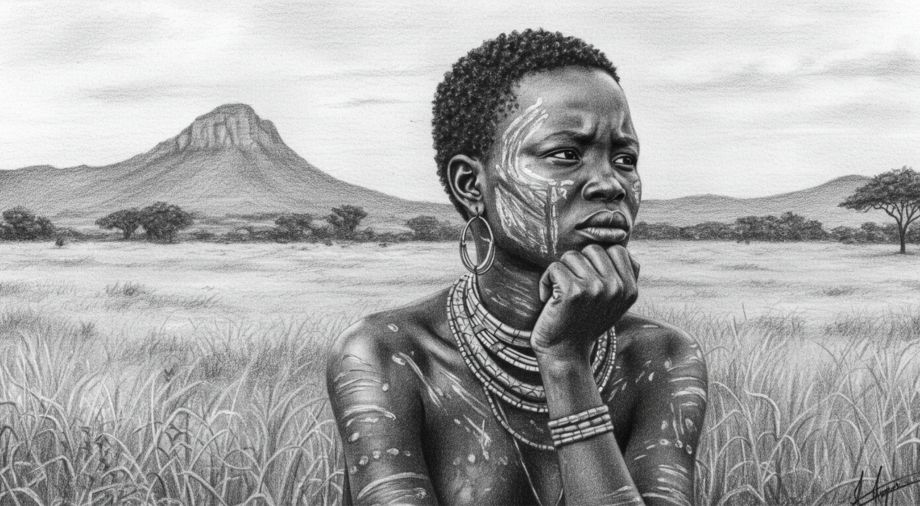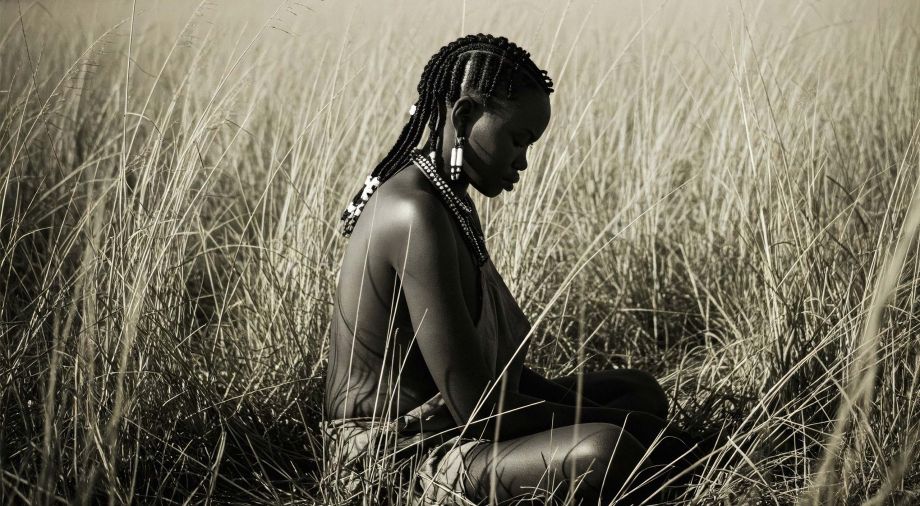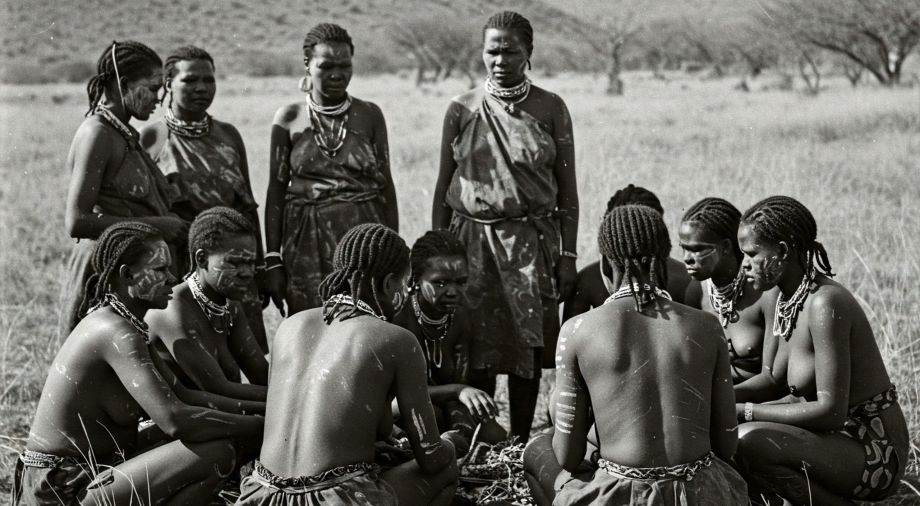Visual Archive
Visual Archive: Historical & Modern Practices
Welcome: This archive presents the cultural and historical practices of labia stretching, including educational illustrations, photos, and community-submitted narratives.
Viewer Discretion Advised: Some sections of this content include contemporary images and descriptions that may be considered explicit or sensitive. These materials are presented solely for illustrative, educational, and cultural purposes to provide insight into current practices and traditions. Viewers should be aware that the content may include graphic or detailed depictions intended to inform and contextualize, and they are encouraged to proceed with discretion.
By proceeding to the Modern Educational Photos section, you acknowledge that you are 18+ and comfortable viewing material intended for educational purposes only.
Manual Labia Stretching
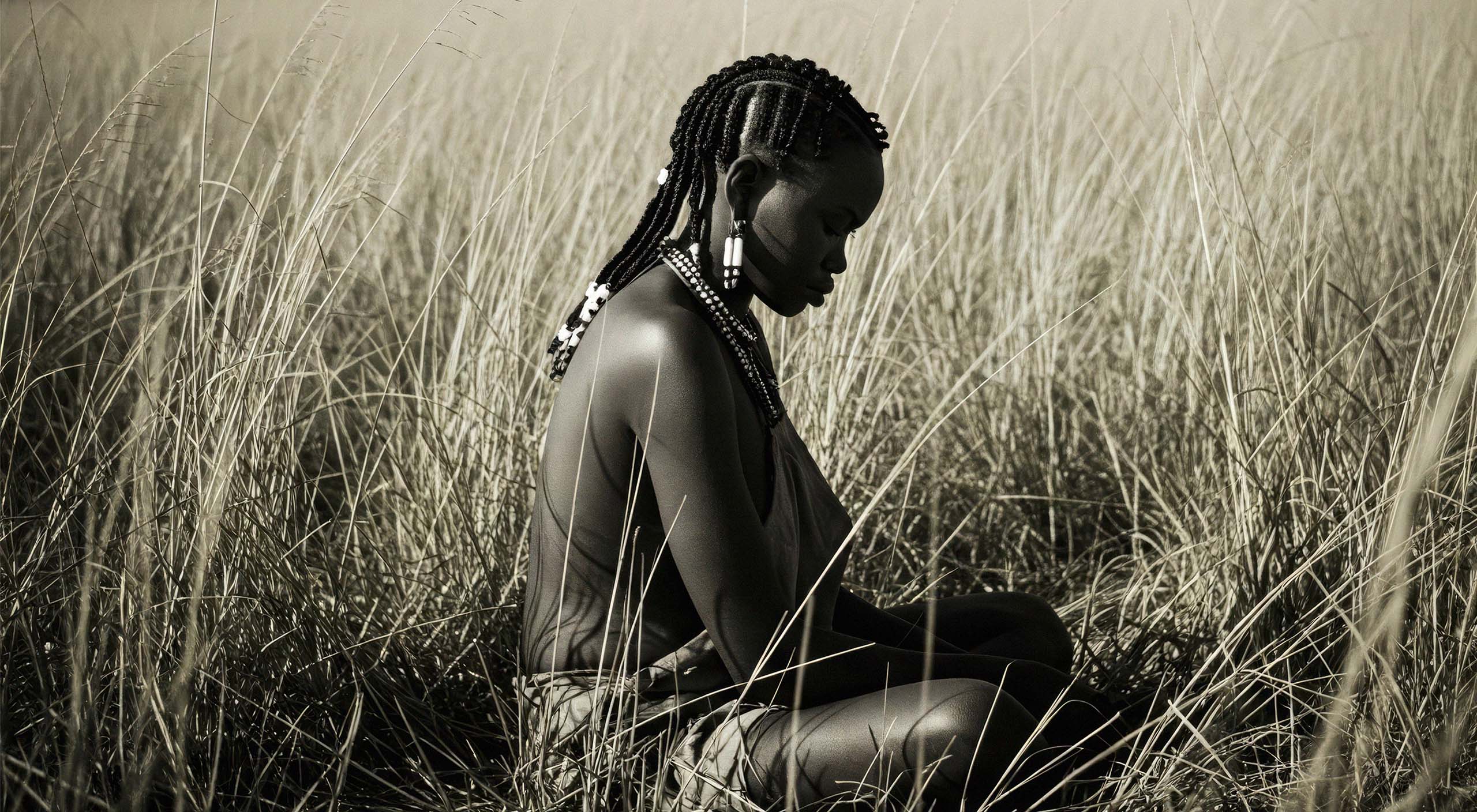
Traditional Practice in the Grasslands
A cultural image showing a Khoisan woman seated quietly in a grass field. The scene symbolizes traditional practices such as manual labia stretching once taught privately within Khoisan communities, highlighting the link between cultural identity, environment, and women’s traditional knowledge.
Tradition, Method, and Meaning
Manual Labia Stretching: Understanding Practice, Purpose, and Cultural Meaning
Manual labia stretching is a traditional and contemporary body practice that involves the gentle and gradual elongation of the labia minora using the hands. While it remains unfamiliar to many outside specific regions, the practice has a long-standing cultural presence in certain African societies and has recently become a subject of renewed curiosity and research worldwide. This article examines what manual labia stretching is, how it is practiced, its cultural background, and what modern science and health professionals say about it—all within an educational and neutral context.
What Manual Labia Stretching Involves
Manual labia stretching typically refers to the process of slowly and consistently pulling or massaging the inner labia (labia minora) to increase their length over time. It is generally done by the individual herself, though in some cultural settings, elder women or peers traditionally guide younger women through the process.
The stretching can be done daily or several times a week. Gentle pulling using the fingers, along with the application of natural oils or lubricants, is common. The practice does not involve cutting, piercing, or any form of tissue removal—distinguishing it clearly from forms of genital mutilation.
Most practitioners emphasize patience, hygiene, and comfort. The degree of stretching and the desired length vary widely, and many stop once they feel a personal sense of completion or comfort with the outcome.
Cultural Context and Traditions
Historical and anthropological studies indicate that manual labia stretching has deep cultural roots in several parts of sub-Saharan Africa, including Uganda, Rwanda, Malawi, and Zambia. In these regions, it has been passed down through generations as part of traditional education for adolescent girls.
Elders or older women, often within initiation ceremonies or private mentorship, introduce the practice as part of preparation for womanhood, intimacy, and marriage. It is sometimes described as a symbol of maturity, beauty, or readiness for partnership.
In Rwandan and Ugandan traditions, for example, elongated labia are occasionally associated with increased sexual pleasure for both partners, and the practice can carry social esteem. However, not all individuals from these regions participate, and perceptions vary—some see it as cultural heritage, while others consider it a personal or outdated custom.
With migration and globalization, manual labia stretching has gained attention in the wider world. Discussions about it now appear in medical journals, academic research, and online communities. In these modern contexts, the practice is often reframed as a form of body modification or personal choice rather than a strictly cultural expectation.
Contemporary Perspectives and Health Considerations
Modern medical perspectives on labia stretching are evolving. Researchers and clinicians generally agree that, when done carefully and hygienically, the practice poses minimal health risks. Studies suggest that gradual stretching using lubricants or oils can be performed safely if infections are prevented and the tissue is not overstressed.
Potential risks arise when hygiene is poor, when excessive force is applied, or when non-sterile objects are used. Pain, tearing, and infection can occur if the practice is done improperly. For this reason, health professionals emphasize cleanliness, awareness of anatomy, and self-consent as essential components.
It’s also worth noting that there is no universal medical benefit associated with the practice. While some individuals report increased sexual satisfaction or comfort with their bodies, others see no physical advantage. The results—both aesthetic and sensory—are highly subjective.
How It Is Practiced Today
In regions where it remains part of traditional teachings, manual labia stretching is often introduced in adolescence, with guidance emphasizing patience and respect for the body.
Outside of these traditional contexts, adults who explore labia stretching today often do so privately, guided by online information or body-modification communities. Common methods include:
-
Preparation: Washing hands thoroughly and cleaning the genital area.
-
Lubrication: Applying natural oils (such as coconut or olive oil) or a water-based lubricant.
-
Technique: Gently pulling the inner labia outward using the fingers for a few minutes at a time.
-
Consistency: Repeating the process regularly—sometimes daily or weekly.
-
Comfort: Stopping immediately if pain, discomfort, or irritation occurs.
Stretching progress varies from person to person, depending on factors such as natural elasticity, frequency, and technique. Some individuals practice for cultural continuity, others for aesthetic preference, and some out of curiosity.
Shifting Meanings and Body Autonomy
In modern conversations about body image and cultural identity, manual labia stretching represents an interesting intersection of tradition, autonomy, and changing norms. For some, it is a valued expression of heritage; for others, it’s a personal exploration of anatomy and sensuality.
In postcolonial academic discourse, researchers have noted that Western perspectives historically misunderstood or stigmatized the practice, often labeling it under broader categories of genital modification without distinguishing its voluntary and non-harmful aspects. Recent scholarship, however, takes a more nuanced view, recognizing that cultural and personal body practices cannot be easily categorized as “right” or “wrong” without context.
Ethical and Cultural Sensitivity
When discussing or studying manual labia stretching, sensitivity is essential. Cultural practices concerning the body often carry deep significance, and external judgments can easily distort understanding.
For individuals exploring this topic, whether academically or personally, the most respectful approach involves acknowledging its historical roots, listening to firsthand voices from the cultures where it originated, and maintaining an evidence-based understanding of safety.
“Manual labia stretching is not an act of harm, but a traditional body practice rooted in patience, respect, and personal choice.”
Open Discussions About Labia Stretching
In Brief
Manual labia stretching is a long-standing body practice involving the gradual elongation of the labia minora.
-
Originates from cultural traditions in parts of Africa.
-
Practiced for reasons including intimacy, aesthetics, or cultural identity.
-
Considered safe when done gently and hygienically.
-
Requires respect for personal choice and cultural context.
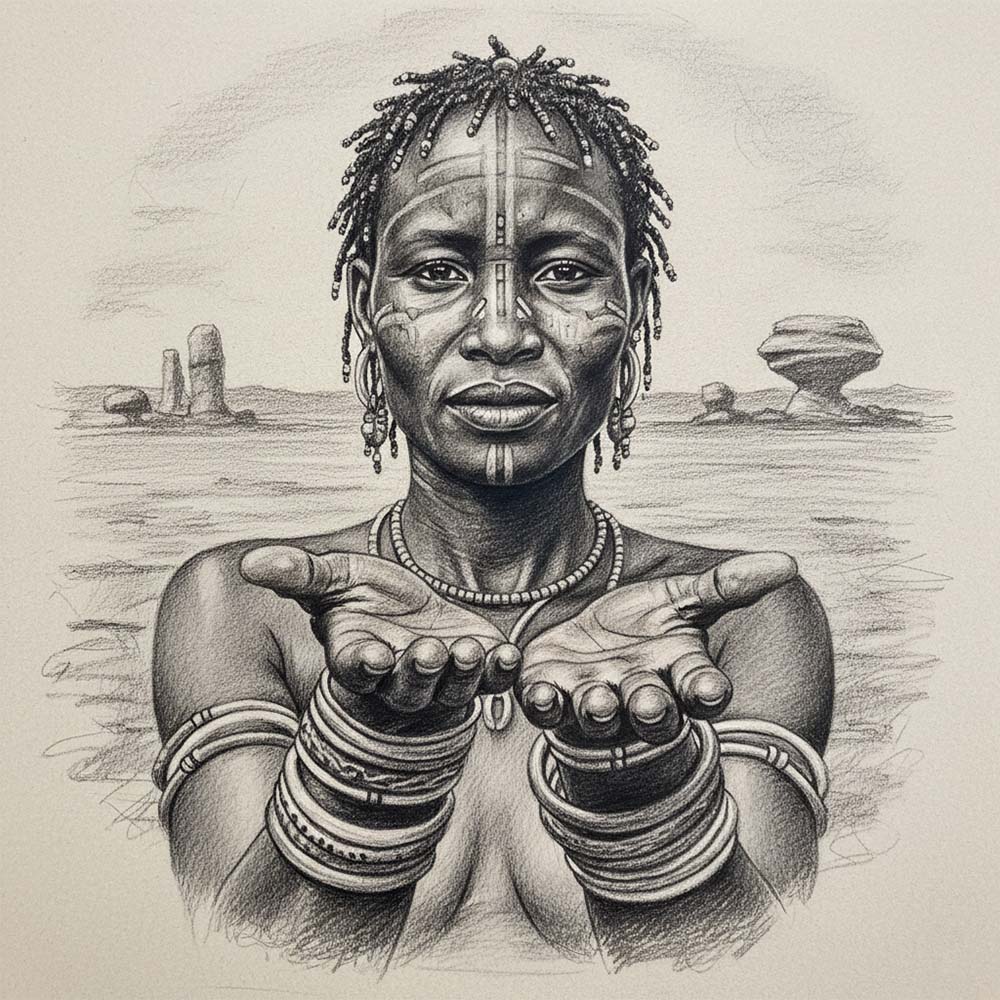
Hands of Knowledge
Image portraying a Khoisan woman seated calmly, holding out her hands in focus. The composition symbolizes that only the hands are used in the traditional practice of manual labia stretching—representing simplicity, body awareness, and the transmission of indigenous knowledge. The artwork conveys respect for tradition and cultural context without explicit visual detail.
Did You Know?
- Anthropologists have documented traditional labia stretching practices as far back as the early 20th century.
-
Some modern body-positive communities view it as similar to earlobe stretching—a natural tissue adaptation over time.
-
Certain cultures include songs, mentorship, or symbolic ceremonies connected to the process of teaching the practice.
Preserving the Tradition
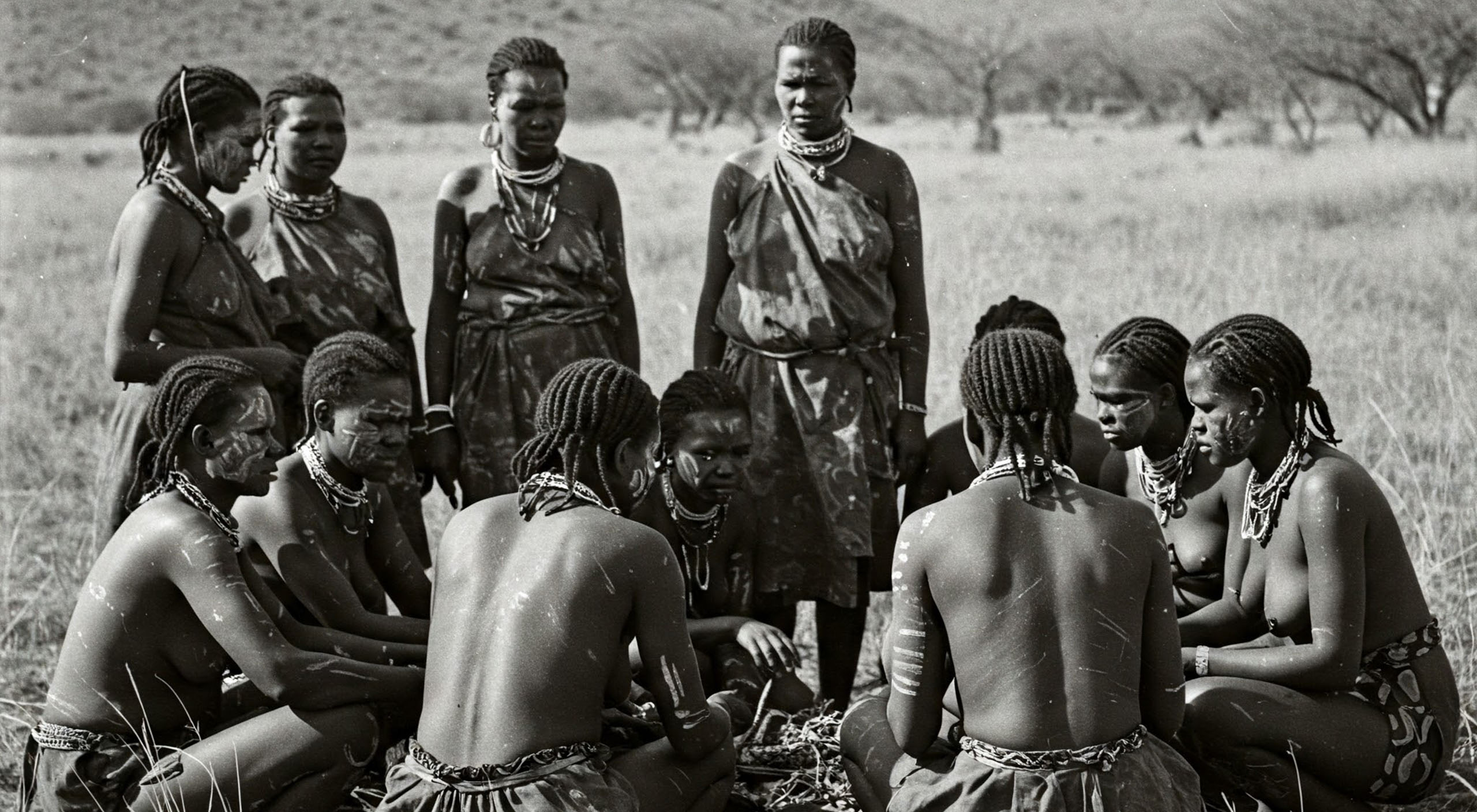
Khoisan Women Gather in Nature to Prepare for Ceremony
Khoisan women gather in harmony in a serene field, ready to begin a traditional ceremonial practice.
A Hidden Heritage
Labia Stretching: Preserving a Fading African Tradition in the Face of Cultural Erosion
In many remote regions of Africa, before the encroachment of foreign ideologies and modern globalization, life thrived in beautifully simplistic ways. People lived in harmony with nature, their bodies, and their communities. Practices that may appear unconventional to outsiders were not only accepted but celebrated—woven into the fabric of everyday life. Among these practices is labia stretching, a form of body modification traditionally passed down through generations of women.
What might appear strange through a Western lens is, in fact, a deeply meaningful tradition among several African ethnic groups. Labia stretching is a practice involving the elongation of the inner labia, often beginning during puberty. It is usually taught by older female relatives, such as aunts or grandmothers, and is considered a rite of passage into womanhood in many communities. This practice is not performed for aesthetic or sexual reasons alone—it is imbued with cultural identity, womanhood, community values, and pride.
But as Africa becomes increasingly interconnected with the outside world, especially through Western and Eastern ideological influence, traditions such as labia stretching are fading into obscurity.
The Simplicity and Freedom of Traditional Life
Before widespread external interference, communities in Africa experienced a lifestyle that, while simple, offered a profound sense of freedom, joy, and connection. Women and girls could engage in practices like labia stretching openly, without shame. Nudity in many of these societies was not taboo; rather, the body was seen as natural, respected, and free of the harsh moral judgments often associated with it in foreign religions and ideologies.
There was no inherent shame in the female form, and many communities embraced body modification, nudity, or body markings as cultural expressions rather than as subjects of scorn. This acceptance fostered a collective confidence and harmony with one's body, something that is starkly absent in societies driven by shame-based teachings and heavy regulation of female behavior.
Labia stretching, in this context, wasn't a medical procedure nor a cosmetic enhancement. It was a symbol of womanhood, maturity, and cultural pride, offering women a sense of identity and purpose within their society.
The Cultural Decline and Western Stigmatization
However, the contact between African societies and Western civilization has led to a deep erosion of this cultural acceptance. Colonial influence introduced not only foreign laws and economies but also Western moral frameworks—many of which clashed with local customs. Practices like labia stretching began to be viewed through lenses of stigma, shame, and misunderstanding.
The practice has increasingly been labeled as "primitive" or "bizarre" by those outside the culture, despite its deeply rooted meaning. This external moral policing has made it difficult for younger generations to carry on such traditions with pride. Even more damaging is the association of any indigenous body modification with misogyny or abuse, despite many African women regarding these rituals as empowering and communal.
Furthermore, the Western preoccupation with genital uniformity and medicalized "normalcy" often leads to pathologizing natural variations in women’s anatomy, casting further doubt and shame on traditional practices like labia stretching.
The Rise of Religious Conservatism and Cultural Suppression
Today, the threats to traditional African practices are not only from the West but also from Eastern and Middle Eastern ideologies, particularly through the spread of conservative Islamic doctrines in sub-Saharan Africa.
The imposition of modesty culture—often spearheaded by male-led religious conversions—has further suppressed women's bodily autonomy. In regions where Islamic extremism or conservatism gains ground, women are increasingly forced to cover their bodies, reject traditional attire, and abandon ancestral practices. The cultural openness once celebrated in many African societies is being replaced with rigid ideologies that demand uniformity, obedience, and invisibility from women.
These religious movements often disregard the richness of local customs, including practices like labia stretching, branding them as sinful, impure, or un-Islamic. As a result, communities are divided, younger generations become alienated from their roots, and elders are silenced or shamed for preserving indigenous knowledge.
The New Wave of Colonization
What began with European colonization centuries ago is now being mirrored by neo-colonial influences from Asia and the Middle East. This modern wave of colonization is not through conquest, but through economic leverage, religious influence, and cultural imperialism. The impact is just as devastating—erasure of identity, loss of self-determination, and destruction of cultural memory.
Africa's vast tapestry of traditions, including labia stretching, is under siege. What once belonged to communities as part of their rich oral history and everyday life now risks becoming mere footnotes in anthropology books. If not preserved, these traditions will vanish without the world ever understanding their beauty, depth, and purpose.
A Call to Remember and Respect
It is vital to approach traditions like labia stretching not with quick judgment but with curiosity, respect, and cultural humility. For many African women, this practice was (and for some, still is) a source of empowerment, bonding, and pride—not shame.
The preservation of such practices isn't just about maintaining rituals—it's about safeguarding autonomy, heritage, and identity. To reduce labia stretching to an outdated curiosity is to misunderstand the intricate tapestry of African womanhood.
The world must move toward a more inclusive understanding of cultural diversity, where communities are allowed to celebrate their practices openly and without shame. Efforts should focus on documenting, preserving, and educating rather than erasing. The goal should not be to judge what we do not understand, but to learn what it means for those who live it.
Honoring the Simplicity of a Culture Without Shame
Sometimes, simpler lives offer richer truths—freedom not burdened by overanalysis, joy not dictated by doctrines, and beauty that isn’t commercialized. Traditional African practices like labia stretching represent more than anatomy—they reflect a worldview of acceptance, community, and femininity.
If the world is to move forward ethically, we must listen more closely to the voices of indigenous women, respect the traditions they hold dear, and resist the impulse to whitewash, shame, or convert every culture into a global sameness.
Because in that sameness, something deeply human is lost.
"When tradition is silenced, identity fades. To preserve culture is to honor the soul of a people."
Open Discussions About Labia Stretching
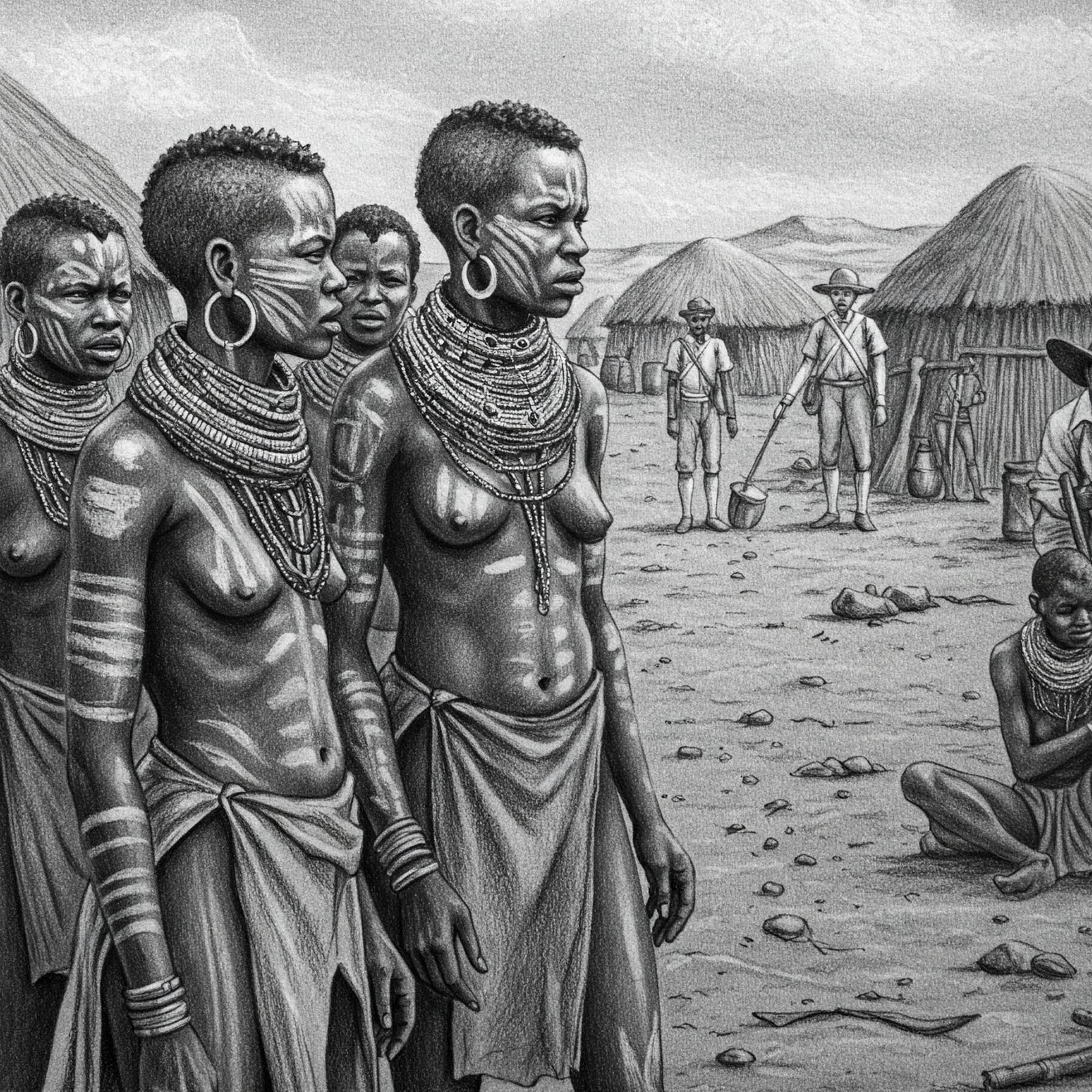
Khoisan Women Witnessing the First Contact with European Explorers
An illustrated depiction of four Khoisan women standing barefoot on dry earth, adorned in traditional attire, observing the bewildering sight of European explorers arriving in their remote African village. The women's expressions are a mixture of caution and curiosity, highlighting the moment of cultural collision and foreshadowing the deep changes colonialism would bring.
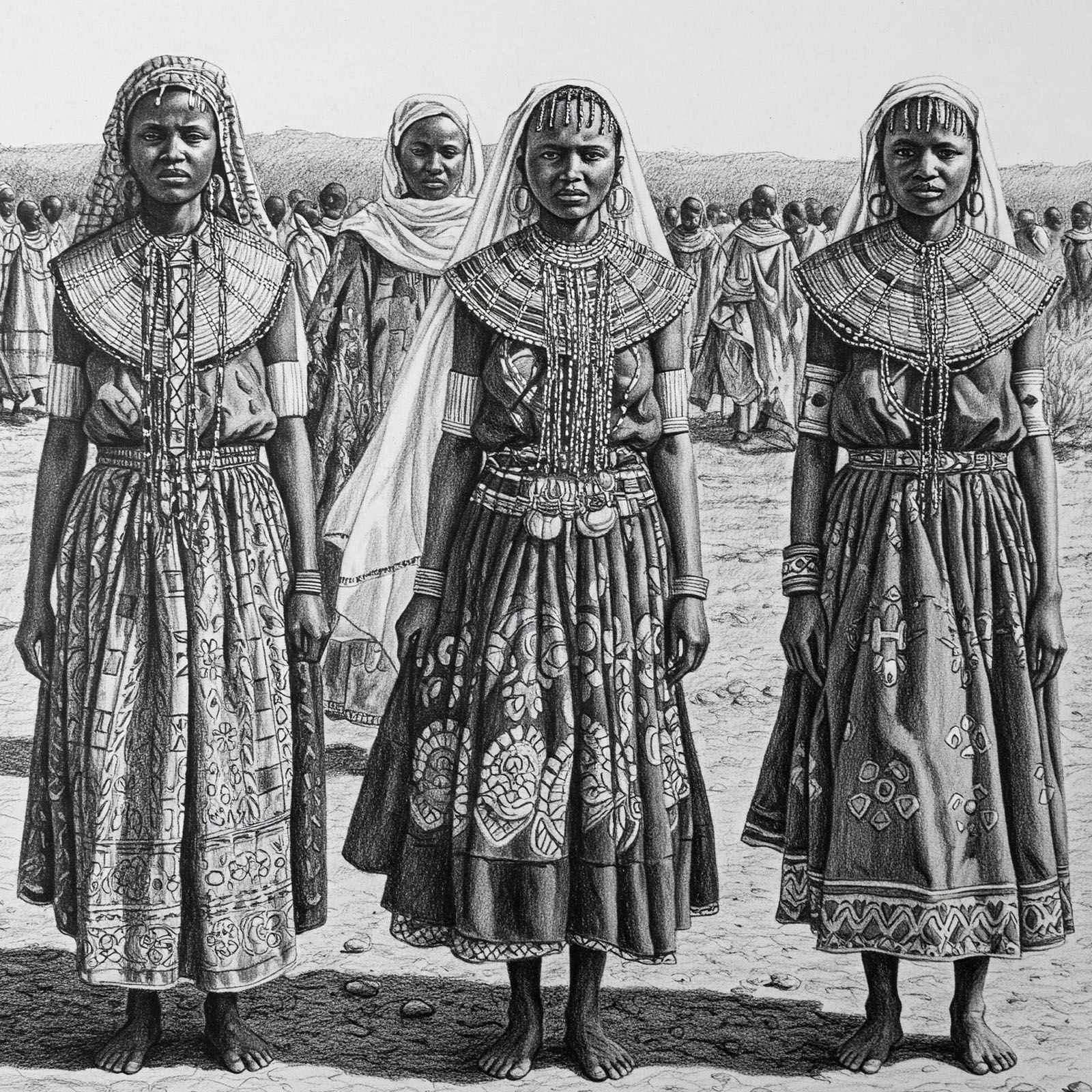
The Modern Erasure: Asian and Middle Eastern Neo-Colonial Influence on African Women's Culture
An evocative image showing African women clothed in conservative, non-traditional attire reflective of Asian and Middle Eastern religious and cultural influence. Their somber faces hint at the internal struggle of lost identity and tradition. In the background, faint outlines of older cultural symbols fade into obscurity, symbolizing the slow erasure of indigenous practices under the weight of neo-colonial imposition.
